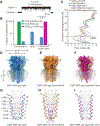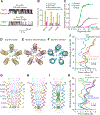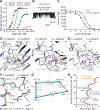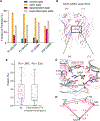Mechanism of gating and partial agonist action in the glycine receptor
- PMID: 33567265
- PMCID: PMC8115384
- DOI: 10.1016/j.cell.2021.01.026
Mechanism of gating and partial agonist action in the glycine receptor
Abstract
Ligand-gated ion channels mediate signal transduction at chemical synapses and transition between resting, open, and desensitized states in response to neurotransmitter binding. Neurotransmitters that produce maximum open channel probabilities (Po) are full agonists, whereas those that yield lower than maximum Po are partial agonists. Cys-loop receptors are an important class of neurotransmitter receptors, yet a structure-based understanding of the mechanism of partial agonist action has proven elusive. Here, we study the glycine receptor with the full agonist glycine and the partial agonists taurine and γ-amino butyric acid (GABA). We use electrophysiology to show how partial agonists populate agonist-bound, closed channel states and cryo-EM reconstructions to illuminate the structures of intermediate, pre-open states, providing insights into previously unseen conformational states along the receptor reaction pathway. We further correlate agonist-induced conformational changes to Po across members of the receptor family, providing a hypothetical mechanism for partial and full agonist action at Cys-loop receptors.
Keywords: SMA; cryo-EM; gating mechanism; glycine receptor; ligand-gated ion channels; partial agonists action.
Copyright © 2021 Elsevier Inc. All rights reserved.
Conflict of interest statement
Declaration of interests The authors declare no competing interests.
Figures







Comment in
-
Partial agonists go molecular.Trends Pharmacol Sci. 2021 Jul;42(7):507-509. doi: 10.1016/j.tips.2021.04.008. Epub 2021 May 6. Trends Pharmacol Sci. 2021. PMID: 33965248
Similar articles
-
Glycine receptor mechanism elucidated by electron cryo-microscopy.Nature. 2015 Oct 8;526(7572):224-9. doi: 10.1038/nature14853. Epub 2015 Sep 7. Nature. 2015. PMID: 26344198 Free PMC article.
-
Disruption of a putative intersubunit electrostatic bond enhances agonist efficacy at the human α1 glycine receptor.Brain Res. 2017 Feb 15;1657:148-155. doi: 10.1016/j.brainres.2016.11.024. Epub 2016 Dec 5. Brain Res. 2017. PMID: 27923639 Free PMC article.
-
The intracellular domain of homomeric glycine receptors modulates agonist efficacy.J Biol Chem. 2021 Jan-Jun;296:100387. doi: 10.1074/jbc.RA119.012358. Epub 2021 Feb 20. J Biol Chem. 2021. PMID: 33617876 Free PMC article.
-
What single-channel analysis tells us of the activation mechanism of ligand-gated channels: the case of the glycine receptor.J Physiol. 2010 Jan 1;588(Pt 1):45-58. doi: 10.1113/jphysiol.2009.178525. Epub 2009 Sep 21. J Physiol. 2010. PMID: 19770192 Free PMC article. Review.
-
Structure and Pharmacologic Modulation of Inhibitory Glycine Receptors.Mol Pharmacol. 2016 Sep;90(3):318-25. doi: 10.1124/mol.116.105726. Epub 2016 Jul 11. Mol Pharmacol. 2016. PMID: 27401877 Free PMC article. Review.
Cited by
-
Mechanism of human α3β GlyR modulation in inflammatory pain and 2, 6-DTBP interaction.Res Sq [Preprint]. 2024 Aug 7:rs.3.rs-4402878. doi: 10.21203/rs.3.rs-4402878/v1. Res Sq. 2024. Update in: Nat Commun. 2025 Jun 5;16(1):5242. doi: 10.1038/s41467-025-60516-8. PMID: 39149480 Free PMC article. Updated. Preprint.
-
A release of local subunit conformational heterogeneity underlies gating in a muscle nicotinic acetylcholine receptor.Nat Commun. 2024 Feb 27;15(1):1803. doi: 10.1038/s41467-024-46028-x. Nat Commun. 2024. PMID: 38413583 Free PMC article.
-
Structure and Mechanism of Glycine Receptor Elucidated by Cryo-Electron Microscopy.Front Pharmacol. 2022 Aug 9;13:925116. doi: 10.3389/fphar.2022.925116. eCollection 2022. Front Pharmacol. 2022. PMID: 36016557 Free PMC article. Review.
-
Molecular Simulations of Hydrophobic Gating of Pentameric Ligand Gated Ion Channels: Insights into Water and Ions.J Phys Chem B. 2021 Feb 4;125(4):981-994. doi: 10.1021/acs.jpcb.0c09285. Epub 2021 Jan 13. J Phys Chem B. 2021. PMID: 33439645 Free PMC article.
-
Correlating ion channel structure and function.Methods Enzymol. 2021;652:3-30. doi: 10.1016/bs.mie.2021.02.016. Epub 2021 Mar 25. Methods Enzymol. 2021. PMID: 34059287 Free PMC article.
References
Publication types
MeSH terms
Substances
Grants and funding
LinkOut - more resources
Full Text Sources
Other Literature Sources
Molecular Biology Databases

